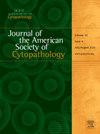ThyroSeq、ThyGeNEXT/ThyraMIR和Afirma分子平台在1252个细胞学不确定甲状腺结节评价中的性能特征
Q2 Medicine
Journal of the American Society of Cytopathology
Pub Date : 2025-04-19
DOI:10.1016/j.jasc.2025.04.003
引用次数: 0
摘要
分子诊断的应用简化了细针穿刺细胞学不确定甲状腺结节的术前风险分层。大多数分子平台使用基因分型和mRNA或microRNA表达谱来确定甲状腺结节的术前癌症风险。材料和方法:在本研究中,我们讨论了一般方法,并比较了3个市售分子平台ThyroSeq、ThyGeNEXT/ThyraMIR和Afirma对1252个细胞学上不确定的甲状腺结节的诊断准确性。结果:分子评价显示28.7%的患者恶性肿瘤风险增高。在所有病例中,209例行部分或完全甲状腺切除术。良性和非肿瘤性甲状腺结节占34.9%,良性肿瘤占16.3%,恶性肿瘤占48.8%。5.5% (n = 49)分子检测阴性的患者在随后的甲状腺切除术中发现肿瘤。良性肿瘤占40.8%,恶性肿瘤占59.2%。结论:ThyroSeq、ThyGeNEXT/ThyraMIR和Afirma分子平台在排除细胞学上不确定的甲状腺结节的恶性肿瘤方面表现出相似的疗效,敏感性分别为87.5%、66.7%和73.1%,阴性预测值分别为80.0%、70.0%和66.0%。在我们的研究中,这些分子平台的整体性能特征不如一些先前发表的研究。本文章由计算机程序翻译,如有差异,请以英文原文为准。
Performance characteristics of ThyroSeq, ThyGeNEXT/ThyraMIR, and Afirma molecular platforms in evaluation of 1252 cytologically-indeterminate thyroid nodules
Introduction
The preoperative risk stratification of thyroid nodules with indeterminate cytology on fine needle aspiration has been streamlined with the application of molecular diagnostics. Most molecular platforms use genotyping and mRNA or microRNA expression profiling to assign a preoperative cancer risk to thyroid nodules.
Materials and methods
In this study, we discuss the general methodology and compare the diagnostic accuracy of 3 commercially available molecular platforms, ThyroSeq, ThyGeNEXT/ThyraMIR, and Afirma, in the evaluation of 1252 cytologically indeterminate thyroid nodules.
Results
Molecular evaluation showed an increased malignancy risk in 28.7% of cases. Of all cases, 209 underwent partial or complete thyroid resection. 34.9% of these resected thyroid nodules were benign and non-neoplastic, 16.3% were benign neoplasms and 48.8% were malignant neoplasms. 5.5% (n = 49) of cases with negative molecular testing were found to have a neoplasm on subsequent thyroid resection. 40.8% of these cases showed benign neoplasms and 59.2% showed a malignant neoplasm.
Conclusions
The ThyroSeq, ThyGeNEXT/ThyraMIR, and Afirma molecular platforms demonstrate similar efficacy in ruling out malignancy in our cohort's cytologically indeterminate thyroid nodules, with sensitivities of 87.5%, 66.7%, and 73.1%, respectively, and negative predictive values of 80.0%, 70.0%, and 66.0%, respectively. Overall performance characteristics of these molecular platforms in our study are inferior to some previously published studies.
求助全文
通过发布文献求助,成功后即可免费获取论文全文。
去求助
来源期刊

Journal of the American Society of Cytopathology
Medicine-Pathology and Forensic Medicine
CiteScore
4.30
自引率
0.00%
发文量
226
审稿时长
40 days
 求助内容:
求助内容: 应助结果提醒方式:
应助结果提醒方式:


